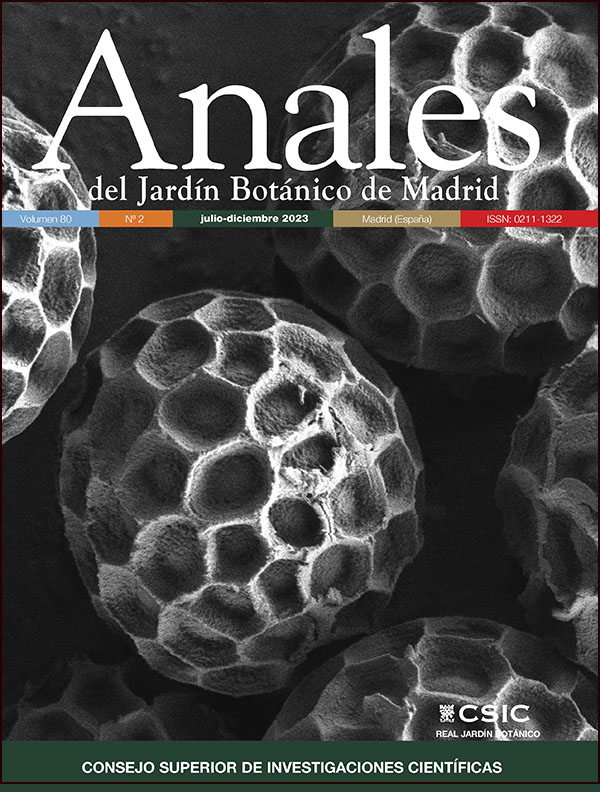A new species and a new synonym in Peruvian Senecio (Compositae)
DOI:
https://doi.org/10.3989/ajbm.598Keywords:
Andes, Asteraceae, Senecioneae, South America, taxonomyAbstract
The species Senecio contumazensis sp. nov. from the southern department of Cajamarca, in northwestern Peru, is described herein. It shows morphological affinities with species of the Senecio series Otopteri, especially with the Bolivian Senecio sepium. In addition, the putative endemic Senecio piurensis from northern Peru is synonymized with S. pericaulis, a species previously described from southern Ecuador. Discussions on the morphology of these species, illustrations, and a distribution map are provided.
Downloads
References
Bachman S., Moat J., Hill A.W., de la Torre J. & Scott B. 2011. Supporting Red List threat assessments with GeoCAT: geospatial conservation assessment tool. ZooKeys 150: 117-126. https://doi.org/10.3897/zookeys.150.2109 PMid:22207809 PMCid:PMC3234434
Beck S.G. & Ibáñez D. 2014. Senecio L. In Jørgensen P.M., Nee M.H. & Beck S.G. (eds.), Catálogo de las Plantas Vasculares de Bolivia. Monographs in Systematic Botany from the Missouri Botanical Garden 127: 361-367.
Beltrán H. 1999. New combinations in Dendrophorbium and Pentacalia (Senecioneae - Asteraceae) from Peru. Compositae Newsletter 34: 50-52.
Beltrán H. & Galán de Mera A. 2022. Patrones de distribución de las especies de Senecio L. (Asteraceae) en el Perú. Revista Peruana de Biología 29: e21463. https://doi.org/10.15381/rpb.v29i1.21463
Beltrán H., Granda A., León B., Sagástegui A., Sánchez I. & Zapata M. 2006. Asteraceae endémicas del Perú. Revista Peruana de Biología [Número especial] 13(2): 64-164. https://doi.org/10.15381/rpb.v13i2.1807
Cabrera A.L. 1985. El género Senecio (Compositae) en Bolivia. Darwiniana 26: 79-217.
Calvo J. & Beltrán H. 2022. Contributions to the Andean Senecioneae (Compositae). Taxonomic novelties for Peru (VII). Mediterranean Botany 43: e73630. https://doi.org/10.5209/mbot.73630
Calvo J. & Pérez Á.J. 2023. On the genus Dendrophorbium in Ecuador: a new species and identification key. Candollea 78: 91-97. https://doi.org/10.15553/c2023v782a1
Dillon M.O. & Hensold N. 1993. Asteraceae. In Brako L. & Zarucchi J.L. (eds.), Catalogue of the Flowering Plants and Gymnosperms of Peru. Monographs in Systematic Botany from the Missouri Botanical Garden 45: 103-189.
Freire S.E., Ariza Espinar L., Salomón L. & Hernández M.P. 2014. Senecio L. In Zuloaga F.O., Belgrano M.J. & Anton A.M. (eds.), Flora Vascular de la República Argentina 7(3): 27-220. Instituto de Botánica Darwinion, Consejo Nacional de Investigaciones Científicas y Técnicas, Argentina.
Funk V.A., Robinson H., McKee G.S. & Pruski J.F. 1995. Neotropical Montane Compositae with an Emphasis on the Andes. In Churchill S.P., Balslev H., Forero E., Luteyn J.L. (eds.), Biodiversity and Conservation of Neotropical Forests: 451-471. Proceedings of the Neotropical Montane Forest Biodiversity and Conservation Symposium. New York Botanical Garden, New York.
Greenman J.M.1923. Studies of South American Senecios-I. Annals of the Missouri Botanical Garden 10: 73-110. https://doi.org/10.2307/2989982
IUCN. 2012. IUCN Red List Categories and Criteria. Version 3.1. Ed. 2. IUCN Species Survival Commission, Gland, Cambridge.
Jeffrey C. 1992. The tribe Senecioneae (Compositae) in the Mascarene Islands with an annotated world check-list of the genera of the tribe. Notes on Compositae: VI. Kew Bulletin 47: 49-109. https://doi.org/10.2307/4110768
Nordenstam B. 1997. A new combination in Dendrophorbium (Compositae-Senecioneae). Compositae Newsletter 31: 22-23.
Nordenstam B. 1999. Dendrophorbium (Cuatrec.) C.Jeffrey. In Jørgensen P.M. & León-Yánez S. (eds.), Catalogue of the Vascular Plants of Ecuador. Monographs in Systematic Botany from the Missouri Botanical Garden 75: 279-280.
Pruski J.F. 2018. Compositae of Central America-VII. Digitacalia, Dresslerothamnus, Pentacalia, Zemisia, their microcharacters, and some other Senecioneae. Phytoneuron 2018-53: 1-112.
Robinson H. & Cuatrecasas J. 1978. A review of the Central American species of Pentacalia (Asteraceae: Senecioneae). Phytologia 40: 37-50. https://doi.org/10.5962/bhl.part.28266
Sagástegui A. 1989. Vegetación y flora de la provincia de Contumazá. CONCYTEC, Trujillo, Perú.
Sánchez-Vega I. & Dillon M.O. 2006. Jalcas. In Moraes M., Øllgaard B., Kvist L.P., Borchsenius F. & Balslev H. (eds.), Botánica Económica de los Andes Centrales: 77-90. Universidad Mayor de San Andrés, La Paz.
Smith A.P. & Young T.P. 1987. Tropical alpine plant ecology. Annual Review of Ecology and Systematics 18: 137-158. https://doi.org/10.1146/annurev.ecolsys.18.1.137
Weberbauer A. 1945. El Mundo Vegetal de los Andes Peruanos. Estudio Fitogeográfico. Estación Experimental Agrícola La Molina, Ministerio de Agricultura, Lima.
Weigend M., Cano A. & Rodríguez E.F. 2005. New species and new records of the flora in Amotape-Huancabamba Zone: Endemics and biogeographic limits. Revista Peruana de Biología 12: 249-274. https://doi.org/10.15381/rpb.v12i2.2398
Published
How to Cite
Issue
Section
License
Copyright (c) 2023 Consejo Superior de Investigaciones Científicas (CSIC)

This work is licensed under a Creative Commons Attribution 4.0 International License.
© CSIC. Manuscripts published in both the print and online versions of this journal are the property of the Consejo Superior de Investigaciones Científicas, and quoting this source is a requirement for any partial or full reproduction.
All contents of this electronic edition, except where otherwise noted, are distributed under a Creative Commons Attribution 4.0 International (CC BY 4.0) licence. You may read the basic information and the legal text of the licence. The indication of the CC BY 4.0 licence must be expressly stated in this way when necessary.
Self-archiving in repositories, personal webpages or similar, of any version other than the final version of the work produced by the publisher, is not allowed.















